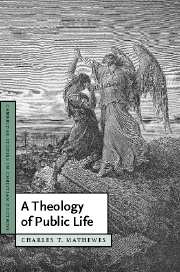Book contents
- Frontmatter
- Contents
- Acknowledgments
- List of abbreviations for works by St. Augustine
- Introduction: Life in the epilogue, during the world
- Part I A theology of engagement
- Introduction to Part I
- 1 Life before God
- 2 Life in the world
- 3 Life together
- Part II The liturgy of citizenship
- Conclusion: The republic of grace; or, the public ramifications of heaven
- List of references
- Index
Introduction to Part I
Published online by Cambridge University Press: 05 June 2012
- Frontmatter
- Contents
- Acknowledgments
- List of abbreviations for works by St. Augustine
- Introduction: Life in the epilogue, during the world
- Part I A theology of engagement
- Introduction to Part I
- 1 Life before God
- 2 Life in the world
- 3 Life together
- Part II The liturgy of citizenship
- Conclusion: The republic of grace; or, the public ramifications of heaven
- List of references
- Index
Summary
Part I of the book explicates the general theology of engagement that undergirds the explicitly political theology unpacked in Part II. It explains how Christians should see the fundamental theological dynamics of their faith as encouraging an ever deepening attachment to our created condition, and it suggests that those dynamics are well articulated in an Augustinian vernacular. Finding such a pro-creation agenda in Augustinian Christian thought will likely surprise many readers. This Introduction explains why it should not.
An Augustinian theology of engagement
Augustine's thought may seem an odd resource for a program of worldly engagement. After all, Augustine often sounds as if he thinks humans have fallen out of heaven into the world. But the surface appearance of his rhetoric – couched in a late antique philosophical vernacular – is deceptive. The deep conceptual and theological underpinnings of his account actually endorse a very different view: a picture of humans as fallen out of creation – out of our condition as creatures in a created world – and into a condition in which we assume we must have absolute mastery over what we see as a world fundamentally other than ourselves. Human sin is “privation” in a way that is not merely etymologically related to privacy: it is solitude, isolation, what Robert Markus calls “man's liability to close in on himself … at bottom, sin [is] a retreat into privacy” (1990a: 51).
- Type
- Chapter
- Information
- A Theology of Public Life , pp. 31 - 42Publisher: Cambridge University PressPrint publication year: 2007



